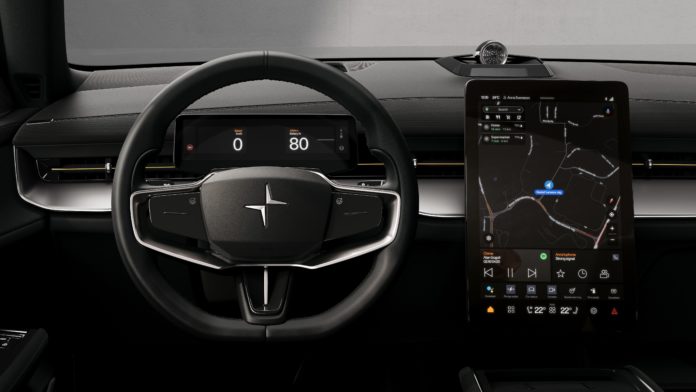Volvo subsidiary Polestar has officially revealed the new Polestar 3 electric performance SUV and it contains lots of interesting tech including an NVIDIA DRIVE core computer, infotainment system powered by Qualcomm’s Snapdragon Cockpit Platform and 14.5 inch screen running Google’s Android Automotive OS.
Thomas Ingenlath, Polestar CEO commented:
“Polestar 3 is a powerful electric SUV that appeals to the senses with a distinct, Scandinavian design and excellent driving dynamics. It takes our manufacturing footprint to the next level, bringing Polestar production to the United States. We are proud and excited to expand our portfolio as we continue our rapid growth.”
Android Automotive OS is the in-car operating system, co-developed with Google and fronted by a 14.5 inch centre display. It is an evolution of the technology first launched in Polestar 2 – the first car in the world with Google built-in.
As with the Polestar 2, over-the-air (OTA) updates are included to allow for continuous software improvement and the introduction of new features without the need to visit a service point.
A 111 kWh battery pack provides Polestar 3 with a huge driving range of up to 610 km WLTP (preliminary measurement) . The lithium-ion battery features a prismatic cell design housed in a protective aluminium case with boron steel reinforcement and liquid cooling. A heat pump is included as standard, helping Polestar 3 utilise ambient heat for climate- and battery preconditioning. Polestar 3 is also equipped for bidirectional charging, enabling future potential for vehicle-to-grid and plug-and-charge capabilities.
Polestar 3 is the first car from Polestar to feature centralised computing with the NVIDIA DRIVE core computer, running software from Volvo Cars. Serving as the AI brain, NVIDIA’s high-performance automotive platform processes data from the car’s multiple sensors and cameras to enable advanced driver-assistance safety features and driver monitoring.
The infotainment system is powered by a next-generation Snapdragon Cockpit Platform from Qualcomm Technologies, Inc. As a central component of the Snapdragon Digital Chassis – a comprehensive set of open and scalable cloud-connected automotive platforms – the Snapdragon Cockpit Platform will be utilised to provide immersive in-vehicle experiences with its high-performance capabilities to deliver high-definition displays, premium quality surround sound and seamless connectivity throughout the vehicle.
As you’d expect for a Volvo subsidiary, Polestar 3 carries next-generation advanced active and passive safety technology from Volvo Cars as part of its DNA. This includes the latest innovation – interior radar sensors that can detect sub-millimetre movements in the interior of the car, to help protect against accidentally leaving children or pets inside. The system is also linked to the climate control system to avoid heat stroke or hypothermia.
As standard, Polestar 3 features a total of five radar modules, five external cameras and twelve external ultrasonic sensors to support numerous advanced safety features.
The SmartZone below the front aero wing collects several of the forward-facing sensors, a heated radar module and camera, and now becomes a signature of Polestar design.
Inside, two closed-loop driver monitoring cameras bring leading eye tracking technology from Smart Eye to a Polestar for the first time, geared towards safer driving. The cameras monitor the driver’s eyes and can trigger warning messages, sounds and even an emergency stop function when detecting a distracted, drowsy or disconnected driver.
Specifications and Pricing
At launch, the Polestar 3 Long range Dual motor (360 kW, 840 Nm) will be available with an indicative launch price of $135,000, though obviously between now and 2024 the price could change a fair bit depending on the strength or weakness of the Australian dollar and other factors.
Australian customers can register their interest online from 13 October 2022.
Polestar 3 Long range Dual motor. Indicative launch price is AUD $135,000 with Plus Pack and Pilot Pack Included. It would be reasonable to expect a less expensive single motor variant to be available as well, though this is yet to be confirmed.
Pilot Pack with LiDAR Optional, expected to be available to order from Q2 2023. Performance Pack EUR 6,600 (Aussiepricing to be confirmed closer to launch)
Power : 360 kW (380 kW with Performance Pack)
Torque : 840 Nm (910 Nm with Performance Pack)
0-100 km/h : (target) 5.0 seconds (4.7 with Performance Pack)
Top speed : 210 km/h
Battery capacity : (nominal) 111 kWh
Battery type : 400V lithium-ion
Battery construction : 204 prismatic cells, 17 modules, aluminium battery case
Range (preliminary, target) : up to 610 km (WLTP)
Electric motor type : Permanent magnet synchronous motors
Electric motor configuration : Dual, front and rear
Torque vectoring : Dual clutch (rear motor only)
Transmission : Single speed
Drag coefficient : 0.29 Cd
Drag force : 0.78 CdA
Charging capacity : (DC) Up to 250 kW
Charging capacity : (AC) Up to 11 kW
Wheelbase : 2,985 mm
Length : 4,900 mm
Height : 1,627 mm (1,614 in Europe)
Width incl. mirrors : 2,120 mm
Ground clearance : 211 mm (201 mm in Europe)
Kerb weight : 2,584-2,670 kg
Weight distribution : 50:50
Towing capacity : (braked) 2,200 kg
Chassis type : Steel unibody
Body type : Steel
Wheels and tyres : Staggered, 21-22 inches
Brakes : Brembo 4-piston, 400 mm drilled and ventilated discs (front). Standard single-piston, 390 mm ventilated discs (rear)
Turning circle : (kerb to kerb) 11,8 m
Suspension : Double wishbone (front)
Integral link : (rear)
Damping : Adaptive, self-levelling dual-chamber air suspension with ZF active dampers
Front storage compartment : 32 litres
Rear luggage capacity (seats up) : 484 litres (incl. 90 under floor)
Rear cargo capacity (seats folded) : 1,411 litres (incl. 90 under floor)
Roof carrying capacity : 100 kg












